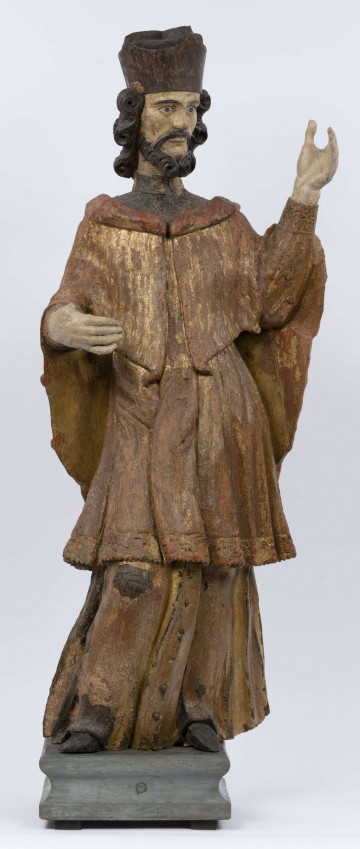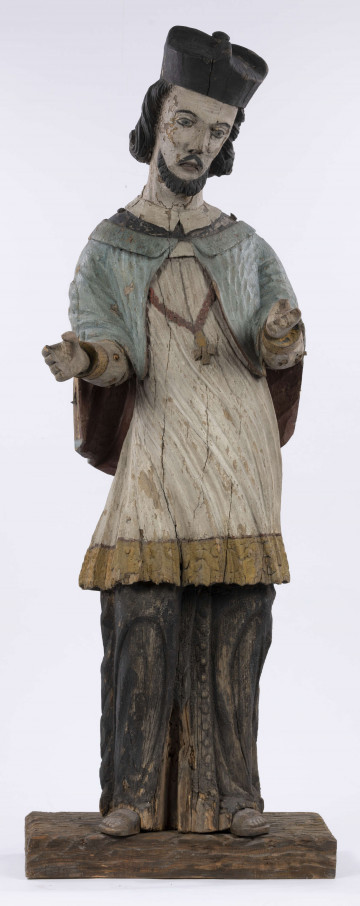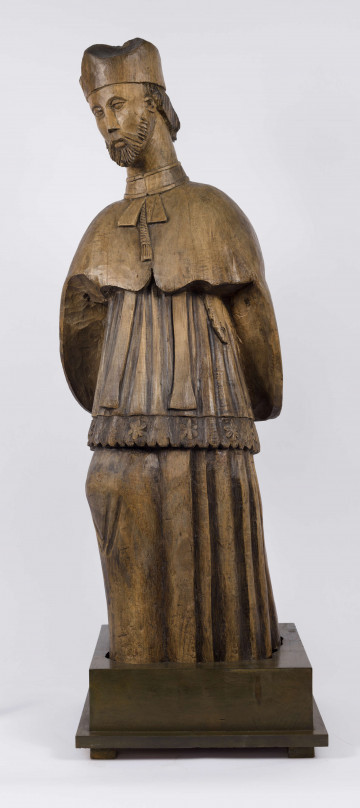
Saint John of Nepomuk
1790 — 1810
National Museum in Lublin
Part of the collection: Folk Art of the Lublin Region (17th–1st half of the 20th c.)
Chapels are one of the most interesting elements of the cultural landscape of Polish villages. They can be found among buildings, near churches, in the forest or by the water, or at the crossroads, and they are the evidence of faith and religious affiliation, as "the faith of the people can be read in the countryside, in the field roads, in old trees, in cemeteries and graves". The variety of their forms is enormous. One of them is the cottage shrine. It is usually a kind of a small house built on a square plan and closed on all sides, with a door in the front wall. There are also chapels open on three sides, planked at the back, or open at the front and planked on the other three sides. The front wall is often decorated with a semicircular arch with a decorative pattern. The whole is covered by a two- or four-sided roof. In the Lublin region small house chapels can be found all over the area, but the largest clusters concentrate in the southern and eastern part, while in the north there are few of them.
Sculptures of saints' protectors were placed in house chapels. The statue of St. John of Nepomuk, the patron saint against flooding and death by drowning, was placed by bridges, rivers or lakes. St Nicholas, patron saint of merchants and fishermen, was placed on the banks of fishing grounds or in dark woods to protect people from wolves. Beekeepers would place a statue of St Ambrose in the hollows of decaying trees near their apiaries. The rafts persons would take images of St Christopher or St Barbara on their rafts. There were also popular representations of: St Joseph with the Infant Jesus, patron of families, St Anthony of Padua, patron of marriages and fiancés and an advocate of lost things, St Stanislaus the Bishop, patron of independent Poland, St Florian, patron of fire brigades, and St John of Nepomuk, patron of fire brigades. The chapel of St. Anthony of Padua, patron of married couples and brides and a protector of lost things, St. Stanislaus the Bishop, patron of independent Poland, St. Florian, patron of firefighters who protects from fire, St. Onufry the Hermit, patron of pilgrims and travellers, St. George, patron of farmers, St. Roch, protector of domestic animals, warding off disease and pest, the Immaculate Conception of the Blessed Virgin Mary and the Sorrowful Christ. Apart from sculptures, folk paintings were often placed in the chapels. Painted on canvas or board or oleo-prints, they depicted, among others: Christ the Saviour, Christ Crucified, Mother of God with Child and saints.
Author / creator
Dimensions
cały obiekt: height: 105 cm
Object type
sculpture
Technique
polychromy
Material
wood, paint
Creation time / dating
Creation / finding place
Owner
The National Museum in Lublin
Identification number
Location / status

1790 — 1810
National Museum in Lublin

1890 — 1910
National Museum in Lublin

1890 — 1910
National Museum in Lublin
DISCOVER this TOPIC
National Museum in Szczecin
DISCOVER this PATH
Educational path